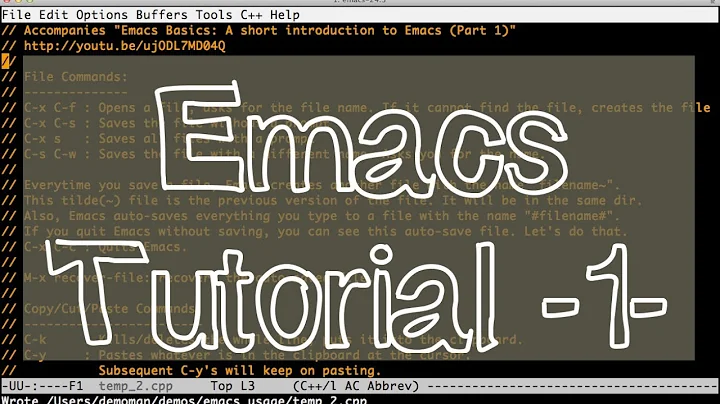How do I duplicate a whole line in Emacs?
Solution 1
I use
C-a C-SPACE C-n M-w C-y
which breaks down to
C-a: move cursor to start of lineC-SPACE: begin a selection ("set mark")C-n: move cursor to next lineM-w: copy regionC-y: paste ("yank")
The aforementioned
C-a C-k C-k C-y C-y
amounts to the same thing (TMTOWTDI)
C-a: move cursor to start of lineC-k: cut ("kill") the lineC-k: cut the newlineC-y: paste ("yank") (we're back at square one)C-y: paste again (now we've got two copies of the line)
These are both embarrassingly verbose compared to C-d in your editor, but in Emacs there's always a customization. C-d is bound to delete-char by default, so how about C-c C-d? Just add the following to your .emacs:
(global-set-key "\C-c\C-d" "\C-a\C- \C-n\M-w\C-y")
(@Nathan's elisp version is probably preferable, because it won't break if any of the key bindings are changed.)
Beware: some Emacs modes may reclaim C-c C-d to do something else.
Solution 2
In addition to the previous answers you can also define your own function to duplicate a line. For example, putting the following in your .emacs file will make C-d duplicate the current line.
(defun duplicate-line()
(interactive)
(move-beginning-of-line 1)
(kill-line)
(yank)
(open-line 1)
(next-line 1)
(yank)
)
(global-set-key (kbd "C-d") 'duplicate-line)
Solution 3
Place cursor on line, if not at beginning do a CTRL-A, then:
CTRL-K
CTRL-K
CTRL-Y
CTRL-Y
Solution 4
My version of a function to duplicate a line that works nice with undo and doesn't mess with the cursor position. It was the result of a discussion in gnu.emacs.sources from November 1997.
(defun duplicate-line (arg)
"Duplicate current line, leaving point in lower line."
(interactive "*p")
;; save the point for undo
(setq buffer-undo-list (cons (point) buffer-undo-list))
;; local variables for start and end of line
(let ((bol (save-excursion (beginning-of-line) (point)))
eol)
(save-excursion
;; don't use forward-line for this, because you would have
;; to check whether you are at the end of the buffer
(end-of-line)
(setq eol (point))
;; store the line and disable the recording of undo information
(let ((line (buffer-substring bol eol))
(buffer-undo-list t)
(count arg))
;; insert the line arg times
(while (> count 0)
(newline) ;; because there is no newline in 'line'
(insert line)
(setq count (1- count)))
)
;; create the undo information
(setq buffer-undo-list (cons (cons eol (point)) buffer-undo-list)))
) ; end-of-let
;; put the point in the lowest line and return
(next-line arg))
Then you can define CTRL-D to call this function:
(global-set-key (kbd "C-d") 'duplicate-line)
Solution 5
Instead of kill-line (C-k) as in C-a C-k C-k C-y C-y use the kill-whole-line command:
C-S-Backspace
C-y
C-y
The advantages over C-k include that it does not matter where point is on the line (unlike C-k which requires being at start of the line) and it also kills the newline (again something C-k does not do).
Related videos on Youtube
deadfish
Updated on May 27, 2021Comments
-
 deadfish almost 3 years
deadfish almost 3 yearsHow can I fix my code under this text?
//puncts = puncts ?? new List<Vector2>() { new Vector2(position.X, position.Y) }; if (Vector2.Distance(position, puncts[indexpunkt] = puncts[indexpunkt] ?? new Vector2(position.X, position.Y) ) < 1) indexpunkt++;Error:
Error 1 Operator '??' cannot be applied to operands of type 'Microsoft.Xna.Framework.Vector2' and 'Microsoft.Xna.Framework.Vector2'I wish create new puncts if it is null and add first element to its list. Can I use operator
??and how can I use it inifstatement?-
Tom almost 10 yearsOf course, it's emacs so TMTOWTDI - there's 22! (and counting) c2.com/cgi/wiki?ThereIsMoreThanOneWayToDoIt
-
-
jfs over 15 years@Allen: remove
[and]in@[Kevin Conner] -
jfs over 15 yearsDo you mean:
C-a C-SPC C-e M-w RET C-y? -
Arthur Thomas over 15 yearsyeah :) that's the precise way hehe.
-
danielpoe over 15 yearsHi! Be aware that if you have '(setq kill-whole-line t)' you will only need one 'C-k' (solution 2) as it already kills the newline together with the contents of the line. My prefered use of 'C-k'. Cheers, Daniel
-
Bastien Léonard almost 15 yearsI don't think the second C-Y is needed.
-
Jitendra Vyas almost 15 yearsit won't be a duplicate without
-
 Rahul Das almost 15 yearsUse C-S-Backspace (kill-whole-line) instead of C-k. You don't have to screw with cursor position or killing the newline.
Rahul Das almost 15 yearsUse C-S-Backspace (kill-whole-line) instead of C-k. You don't have to screw with cursor position or killing the newline. -
viam0Zah almost 14 years@Aurthor Thomas: Why kill? Why not simply copy?
-
viam0Zah almost 14 yearsAs for version 23, it is the part of the standard GNU Emacs distribution as well.
-
Arthur Thomas almost 14 yearsArthur Thomas, it is spelled right there! haha. Ctl-W is fine too. He was just asking about a single line. wow.
-
qmega over 13 yearsIt doesn't seem to be in my version. Does something have to be loaded? My version is
GNU Emacs 23.2.1 (amd64-portbld-freebsd8.1) of 2010-11-14 on [host clipped]. -
ptrn almost 13 yearsExcellent! The undo and cursor position feature makes this one the best. Thanks!
-
Dmitry over 12 years@qmega You need to do (require 'misc).
-
 deadfish over 12 yearsso, I cannot do anything in if statement with my vector2?
deadfish over 12 yearsso, I cannot do anything in if statement with my vector2? -
Ethan Cabiac over 12 yearsyou can do lots of things in an if statement with a vector2, you just can't check if it is null. That would be like saying int i; if(i == null){...}
-
annonymously over 12 yearsActually it would probably be more like saying int i; if(i == "hello") {...}
-
Rohaq about 12 yearsI'm getting the following error with this:
Symbol's function definition is void: move-beginning-of-line -
David Gomes about 12 yearsThe problem with this is that "Del" key is also binded to duplicating the line...
-
tofutim almost 12 yearsThis really is embarassing.
-
JS. almost 12 yearsKudos @RayVega! I tried this solution and it works like a champ (in my GNU Emacs 23.3.1, anyway). Is this solution not working for some people? This is the best answer to your (own) question.
-
ericzma over 11 yearsWhat about
C-S-backspace C-y C-y? -
Ollie Saunders almost 11 yearsWould be nice to have a version that did this without modifying the kill ring or the cursor position
-
Chris Conway almost 11 yearsYou think Emacs can't do that? stackoverflow.com/questions/637351/…
-
katox over 10 yearsSomewhat easier is to hit
C-S-Backspacefollowed byC-yC-y. Which means kill current complete line and then put it back twice. -
phils over 10 yearsAll things considered, Emacs mandates very little -- the huge win that it gives you is the ease of customising it to your own needs. Of course in practice there are lots of standard ways of doing things which it's beneficial to stick to, but if you're using "default" Emacs and doing something a harder way than necessary just because you think "it's better to use the standard", you're pretty much doing it wrong.
-
 Peter Wood over 10 years@tofutim Indeed. In Netbeans I do C-S-down.
Peter Wood over 10 years@tofutim Indeed. In Netbeans I do C-S-down. -
Chris Conway over 10 years@PeterWood Seriously? You think this operation is so important that it must be mapped to a single keystroke? I do this in Emacs literally every day and the key sequence above never enters my conscious mind.
-
Bala over 10 yearswhat is M-w ? which key to use for that ?
-
Chris Conway over 10 years@Bala "M" is "Meta" (usually Esc or Alt, it depends on your keyboard layout). "M-w" is "Meta" and "w" simultaneously (on my keyboard, "Alt-w").
-
pcarvalho about 10 yearsalso, on the link there's some code for regions too!
-
Plankalkül almost 10 yearsVery nice solution. Thx
-
Alexander Shcheblikin over 9 yearsSo, any ideas of how to un-bind
Delfrom this function? -
Alexander Shcheblikin over 9 yearsOK, found a solution to reverting
Delback to normal while keeping the newC-d:(global-set-key (kbd "<delete>") 'delete-char)needs to be added after theC-ddefinition. -
Zelphir Kaltstahl over 8 yearsTrying that on an empty line results in inserting two lines, instead of only one. I don't know why. Is there an easy fix?
-
Davor Cubranic about 8 yearsReally? Which "recent" Emacs would that be? Not the case with 24.4: you get "The mark is not set now, so there is no region."
-
Davor Cubranic about 8 yearsYou should accept this answer as the correct one. It does exactly what you asked for, and in "the least number of commands".
-
Louis Kottmann about 8 yearscurrent Emacs is 24.5, and
M-wis bound toeasy-kill. Check that's what you get when you doC-h c M-w -
Ha-Duong Nguyen over 7 yearsThis is a bad answer, definitely should not be considered as the accepted answer. Relying on keybindings leads to unexpected consequences, especially when people re-bind default ones.
-
 McBear Holden over 7 yearsYou should try the great evil mode
McBear Holden over 7 yearsYou should try the great evil mode -
junius about 7 yearsI put this in my .emacs file, but when I try to use
C-c dI get the errorcommand-execute: Wrong type argument: commandp, duplicate-line-or-region. Any idea what's up? I'm using Emacs 25.1.1 on Windows -
 Alex Trueman about 7 yearsReally nice solution, I appreciate the region feature and the commenting-with-negative-argument feature. Also like the suggested key binding.
Alex Trueman about 7 yearsReally nice solution, I appreciate the region feature and the commenting-with-negative-argument feature. Also like the suggested key binding. -
tejasbubane about 7 yearsThis is nice. Thanks!
-
 Stryker almost 7 yearsThis works nicely but isn't there a short way to do this?
Stryker almost 7 yearsThis works nicely but isn't there a short way to do this? -
 Stryker almost 7 yearsWorks great. Thanks for the solution.
Stryker almost 7 yearsWorks great. Thanks for the solution. -
Derek Mahar over 6 yearsDidn't work in Emacs 24.5.1. Copied only from start of line to point at the beginning of the same line after inserting a preceding blank line.
-
Dodgie over 6 yearsNote that this will mess with kill ring.
-
bartlomiej.n almost 6 yearsThis has to be the most straightforward method here. Thanks!
-
rofrol almost 6 years@pesche
crux-duplicate-current-line-or-regionworks better for me, because with your function it undos line duplication and last operation also. -
Mark almost 6 yearsThis appends the line onto itself when it is the last line and the file does not end in a new line
-
 MarkSkayff almost 4 yearsLooks like not there by this dates.
MarkSkayff almost 4 yearsLooks like not there by this dates. -
knobo over 3 years(progn (beginning-of-line)(insert (thing-at-point 'line)))
-
Steve Eynon almost 3 yearsI love the addition of
move-line-up/down- for that was going to be my next question! -
Kirk Walla almost 3 yearsThis is probably my favourite approach since it requires the least amounts of keystrokes.
-
Kirk Walla almost 3 years@junius
C-c dis reserved kbd forkill-whole-line, use another kbd. -
Michael Terry over 2 yearsUnfortunately, as was the case for me: "Note that many text terminals will prevent you from typing the key sequence C-S-backspace." gnu.org/software/emacs/manual/html_node/emacs/…








